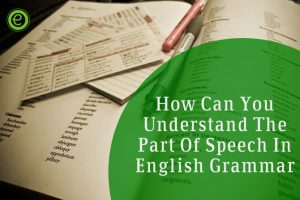Today, we would start learning English Grammar by discussing “Part Of Speech”.
Just imagine every sentence in English as a pile of jumbled words. How would you feel? Will you be able to understand what is written? Can you bring out the meaning of the sentence through the jumbled set of words?, I guess NO.

Significance Of Parts of Speech in English Grammar
English Grammar has been considered as one of the most important elements of the language. Without the proper use of grammar, the sentences make no sense to the readers. But unfortunately, some people find it very complex and difficult to understand it. So we are here to help them understand the basics of English Grammar and how to use it in a proper way.
Through this post, we will help you how “part of speech” can make a difference in various situations right from informal conversations to professional communication. Also, you would able to efficiently focus on concepts of grammar that are most important.
What Do you mean by “Part Of Speech”?
Basically, in English Grammar “part of speech” is defined as the group of words in which each word is allocated to something that is based on its syntactic functions. In English, you would be learning eight part of speech. These eight parts are
- Nouns
- Pronouns
- Verb
- Adverb
- Adjective
- Preposition
- Conjunction
- Interjection
The purpose behind a part of speech is to allocate any function of a word in a sentence to understand the meaning and grammar.
It must always be noted that you can categorize different words into a different section of “part of speech” based on the factor as to how they are used. Hence it is important to understand all the different parts of speech that you wish to define the different meaning of words in a sentence.
With this, let’s have an insight into various types of speeches in the English language.
Let’s start with Nouns.
1. Nouns to Name Person, Place or Thing
Noun: It is a word that has the ability to describe a person, thing or place. You won’t be surprised to know the function of the noun in a sentence. It needs to provide answers to the basic question like who or what.
See the example
- The baby is trying to jump over the wall.
In the above sentence, you can see that there are two nouns, the baby, and then the wall.
Some of the characteristics of a noun are:
- It can either be abstract or concrete.
- It can be proper or common.
- It can either be singular or plural.
2. Pronouns to Replace Noun Words
Pronoun: We can say that a pronoun is a word that would replace a noun. It happens when the noun is not used in the sentence. Checkout the examples:
Mayank is married. He is a happy man.
Here we can see that He is a pronoun and subject of the sentence.
There are 8 Different types of Pronouns prevents repeating the name of the noun again and again:
- Possessive Pronoun
- Reflexive pronoun
- Reciprocal pronoun
- Relative Pronoun
- Demonstrative pronoun
- Interrogative Pronoun
- Indifinite Pronoun
3. Adjectives to Describe Nouns and Pronouns
The adjectives are words that describe nouns or pronouns in a sentence. They are always used before a noun.
There are different types of adjective words to describe how an object or a place or a person is.
4. Verbs to Describe State or Actions
A verb is usually considered as the doing word. It is a word that describes the state of action in a sentence.
Two or more words when joined together in a phrase are called phrasal verbs. There are mainly four types of phrasal verbs where each phrase consists of the verb along with a preposition or an adverb.
5. Adverbs to Describe Verbs
Adverb: Similar to adjectives, they describe or give more information about nouns. In most of the sentences, the adverb will end with -ly in the end.
6. Prepositions To Show Relation Between Nouns
It is quite simple to note that, preposition are words that work in conjunction with either pronoun or a noun. There are different types of prepositions to give directional, temporal and spatial meaning to the words.
7. Conjunctions to Join Phrases or Sentences
We can say that conjunction words are joining words. Their main aim is to join two different sentences or independent clauses.
There are three types of Conjunctions or Connectives:
- Subordinating Conjunctions
- Coordinating Conjunctions.
- Correlative Conjunctions
8. Interjections to Express Emotions or Feeling
Interjections are usually just a single word – and their job is to bring emotions and feeling to a given sentence.
They usually make use of exclamation marks, but they don’t necessarily have to.
There are mainly six types of interjections using which we can express human emotions in writing.
Keep Learning with EnglishBix!

